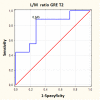The role of MR imaging in detection of hepatic iron overload in patients with cirrhosis of different origins
- PMID: 20105330
- PMCID: PMC2834605
- DOI: 10.1186/1471-230X-10-13
The role of MR imaging in detection of hepatic iron overload in patients with cirrhosis of different origins
Abstract
Background: There are many pathological conditions with hepatic iron overload. Classical definite diagnostic methods of these disorders are invasive and based on a direct tissue biopsy material. For the last years the role of MR imaging in liver diagnostics has been increasing. MRI shows changes of liver intensity in patients with hepatic iron overload. Changes in MR signal are an indirect consequence of change of relaxation times T2 and T2*, that can be directly measured. The purpose of the study was to evaluate usefulness of MR imaging in the detection of hepatic iron overload in patients with cirrhosis of different origins.
Methods: MR imaging at 1.5T was prospectively performed in 44 patients with liver cirrhosis who had undergone liver biopsy with histopathological assessment of hepatic iron deposits. In all patients the following sequences were used: SE, Express, GRE in T2 and T1-weighted images. Signal intensity (SI) was measured on images obtained with each T2 weighted sequence by means of regions of interest, placed in the liver and paraspinal muscles. The correlation between iron overload, histopathological score, serum ferritin and SI ratio was analyzed.
Results: In 20 patients with iron overload confirmed by the biopsy, the liver parenchyma demonstrated lower signal intensity than that of paraspinal muscles. This effect was visible only in 8 patients with hepatic iron overload in Express T2-weighted images. Higher signal intensity of liver than that of skeletal muscles on GRE - T2 weighted images was noted in 24 patients with cirrhosis and without elevated hepatic iron concentration. We observed a correlation between low and high iron concentration and liver to muscle SI ratio.
Conclusion: MR imaging is a useful and fast noninvasive diagnostic tool for the detection of liver iron overload in patients with cirrhosis of different origins.Liver to muscle SI ratio in GRE-T2-weighted sequence facilitates to differentiate patients with low and high degree of hepatic iron overload, which correlates with the origin of liver cirrhosis.
Figures















References
-
- Edwards CQ, Griffen LM, Goldgar D, Drummond C, Skolnick MH, Kushner JP. Prevalence of hemochromatosis among 11,065 presumably healthy blood donors. N Engl J Med. 1988;318:1355–1362. - PubMed
-
- Phatak PD, Sharm RL, Raubertas RF, Dunnigan K, O'Leary MT, Braggins C, Cappuccio JD. Prevalence of hereditary hemochromatosis in 16031 primary care patients. Ann Intern Med. 1998;129:954–961. - PubMed
-
- Kuntz E. Hepatology principles and practice. 2. Springer Verlag; 2006. p. 618.
-
- Burt A, Portmann B, Ferrell L, Eds. MacSween's pathology of the liver. Genetic and metabolic liver disease. Disorders of iron metabolism. London Churchill Livingstone Elsevier; 2007. pp. 256–284.
Publication types
MeSH terms
Substances
LinkOut - more resources
Full Text Sources
Medical

